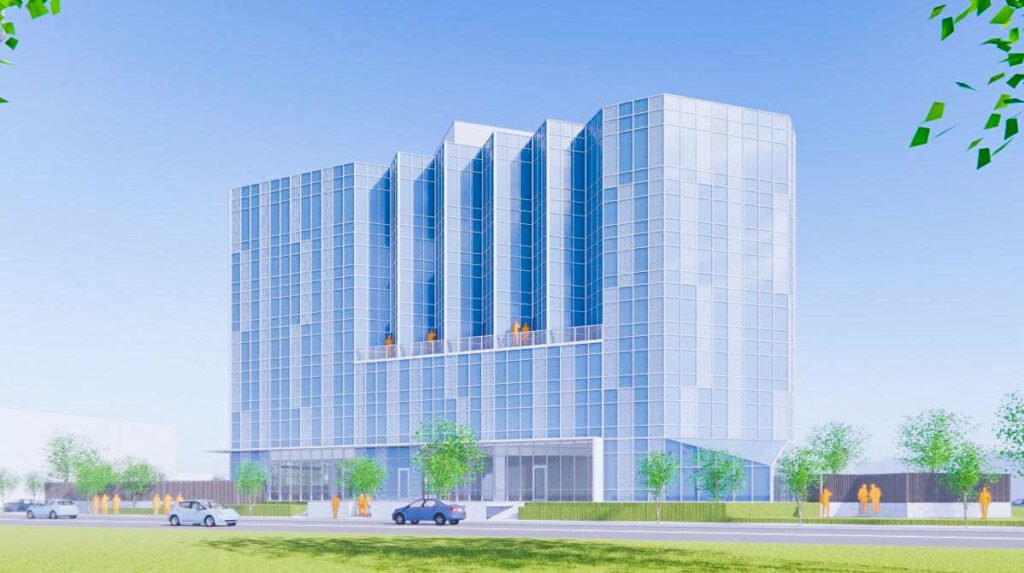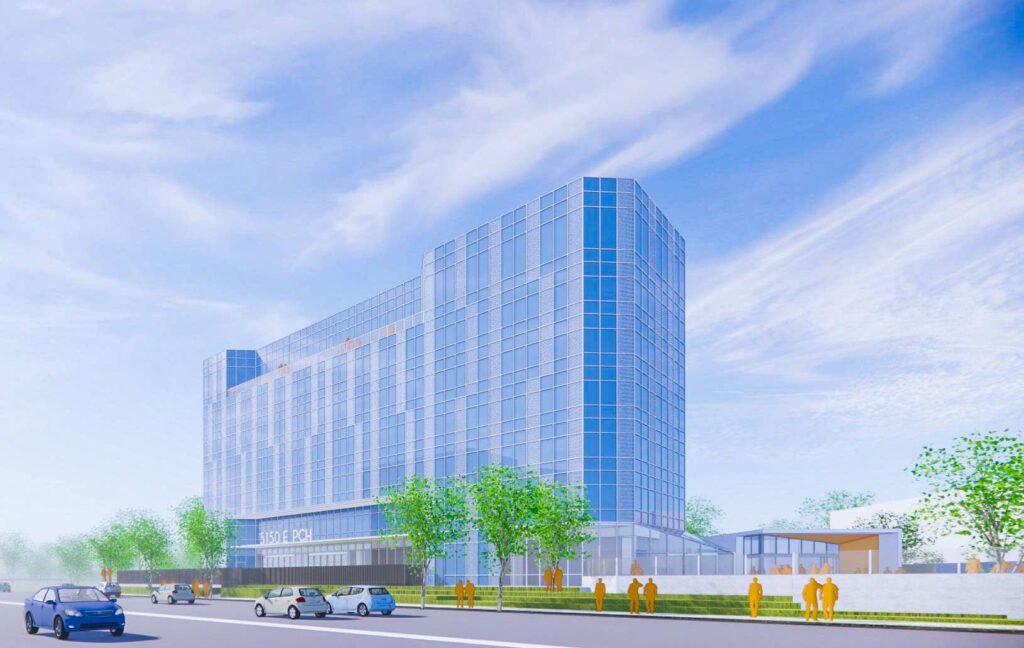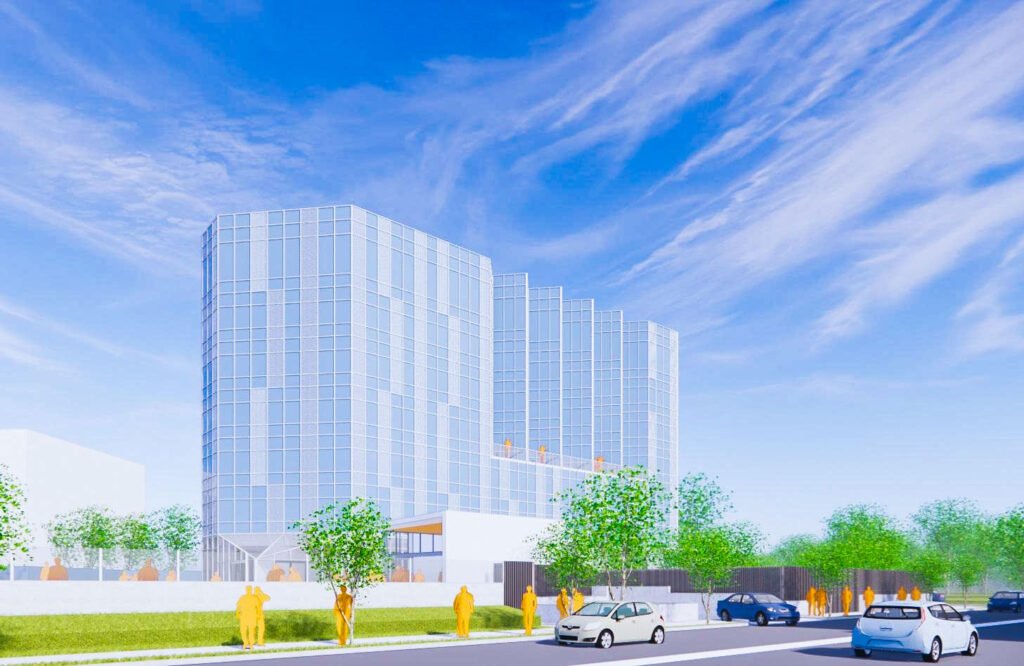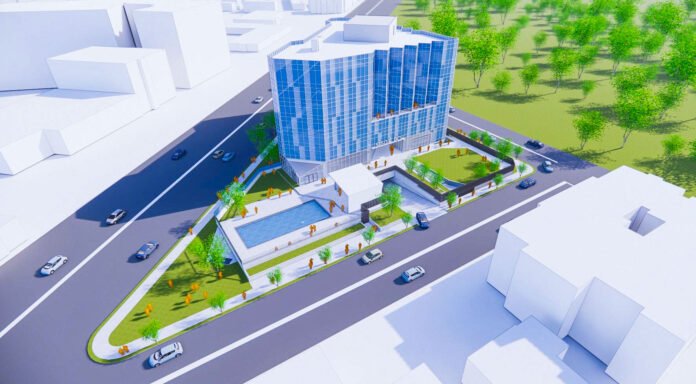Long Beach will eventually see a significant boost to its student housing stock with the planned conversion of a long-vacant office building at 5150 E. Pacific Coast Hwy. into a private dormitory. Following approval from the city’s Planning Commission back in September, the plan has now received formal approval from our City Council. And with a design from the rightfully loved firm Studio One Eleven and the underrated Burnham Development, 149 units are very likely to be built for CSULB students in the future.
The adaptive reuse project would transform the seven-story, 120,000-square-foot office tower into 149 residential suites designed to house nearly 600 students. Units range from one-person studios to six-person shared suites, with most built for four to five residents. The first floor will feature management offices and a wide range of student-focused amenities, including study rooms, a communal kitchen and dining area, laundry facilities, and a fitness center. Outdoors, the plans call for over 22,000 square feet of shared open space with a wade pool, pavilion, BBQs, patios, and landscaped lounges.
This project was first reported by Urbanize LA.

Adaptive re-use is a smart way to increase any form of housing—but especially CSULB housing.
By reusing an underutilized 1980s office complex, the project breathes new life into a declining commercial corridor while meeting a pressing need. With more than 76,000 students attending CSULB, LBCC, and Pacific Coast University combined—but only three dormitories citywide, all serving CSULB—the lack of student housing has long reinforced Cal State Long Beach’s commuter-school reputation. The proposed dorm is just a mile from CSULB and sits directly along major bus routes, making it a sustainable alternative that cuts down commutes, reduces carbon emissions, and helps integrate students more fully into the city.
Transportation access is central to the plan. Though dorms are exempt from parking minimums when located along transit corridors, the project will still offer 364 underground parking spaces across three garage levels, as well as 150 bicycle parking spaces and lockers. The site connects directly to existing Class II bike lanes on Pacific Coast Highway and sits within 1,000 feet of multiple Long Beach Transit stops, including one directly in front of the building. Developers are also exploring shuttle, carshare, and scooter programs to further reduce reliance on cars.

The larger housing strategy for Long Beach.
Long Beach has set an ambitious course to address one of California’s most pressing challenges: housing. Guided by its Housing Element and Land Use Element, the city’s strategy emphasizes adding more homes across the spectrum—market rate, affordable, and special needs housing—while focusing on high-resource areas near jobs, transit, and schools. The approach reflects both state housing mandates and the city’s own recognition that its future depends on diversifying housing options for students, families, seniors, and low-income residents.
At the center of this push is adaptive reuse. With office demand shrinking, Long Beach is reimagining older commercial buildings as residential space—an effort that both extends the life of underutilized properties and reduces waste tied to new construction. Paired with incentives for infill development and mixed-use projects along transit corridors, the city is trying to grow without sprawl, weaving housing into existing neighborhoods in ways that are compatible, sustainable, and tied to the city’s Climate Action Plan.

The strategy also leans heavily on partnerships. Through the Housing Promise Initiative with CSULB, LBCC, and LBUSD, the city is tackling the shortage of student housing, while collaborations with nonprofits and developers aim to boost affordable housing production. The end goal is clear: to make Long Beach less of a commuter city and more of a place where people—whether students, workers, or families—can live close to the opportunities that define their daily lives.
This article was originally published on Sept. 19, 2025; it has since been updated with more relevant information.



I would hardly characterize the building as “long vacant.” My CPA lost his lease there and moved moved to Newport Beach last year. Repurposed because C.S.U.L.B. has more money to spend than the tenants had so they got kicked out. C.S.U.L.B. students will now live an a nice “repurposed” hi-rise.
Glad to see your still doing great work!